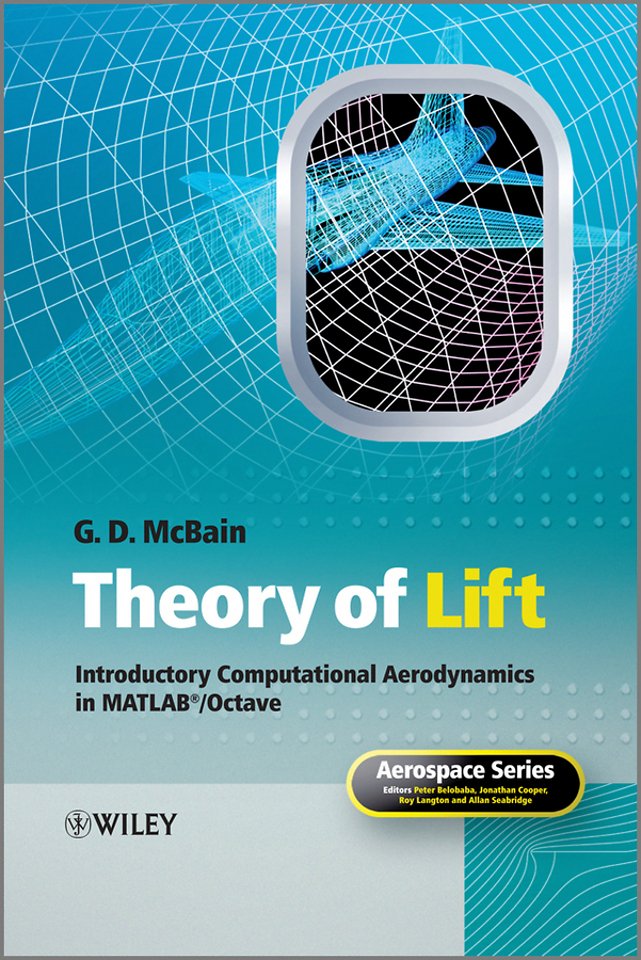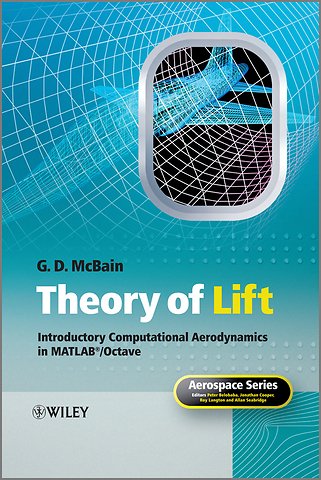Theory of Lift – Introductory Computational Aerodynamics in MATLAB (R)/Octave
Introductory Computational Aerodynamics in MATLAB/Octave
Samenvatting
Starting from a basic knowledge of mathematics and mechanics gained in standard foundation classes, Theory of Lift: Introductory Computational Aerodynamics in MATLAB/Octave takes the reader conceptually through from the fundamental mechanics of lift to the stage of actually being able to make practical calculations and predictions of the coefficient of lift for realistic wing profile and planform geometries.
The classical framework and methods of aerodynamics are covered in detail and the reader is shown how they may be used to develop simple yet powerful MATLAB or Octave programs that accurately predict and visualise the dynamics of real wing shapes, using lumped vortex, panel, and vortex lattice methods.
This book contains all the mathematical development and formulae required in standard incompressible aerodynamics as well as dozens of small but complete working programs which can be put to use immediately using either the popular MATLAB or free Octave computional modelling packages.
Key features:
Synthesizes the classical foundations of aerodynamics with hands–on computation, emphasizing interactivity and visualization.
Includes complete source code for all programs, all listings having been tested for compatibility with both MATLAB and Octave.
Companion website (www.wiley.com/go/mcbain) hosting codes and solutions.
Theory of Lift: Introductory Computational Aerodynamics in MATLAB/Octave is an introductory text for graduate and senior undergraduate students on aeronautical and aerospace engineering courses and also forms a valuable reference for engineers and designers.
Specificaties
Inhoudsopgave
<p>Series Preface xxiii</p>
<p>PART ONE PLANE IDEAL AERODYNAMICS</p>
<p>1 Preliminary Notions 3<br /> 1.2 Aircraft Geometry 5<br /> 1.3 Velocity 8<br /> 1.4 Properties of Air 8<br /> 1.5 Dimensional Theory 13<br /> 1.6 Example: NACA Report No. 502 18<br /> 1.7 Exercises 19<br /> 1.8 Further Reading 22</p>
<p>2 Plane Ideal Flow 25<br /> 2.1 Material Properties: The Perfect Fluid 25<br /> 2.2 Conservation of Mass 26<br /> 2.3 The Continuity Equation 26<br /> 2.4 Mechanics: The Euler Equations 27<br /> 2.5 Consequences of the Governing Equations 30<br /> 2.6 The Complex Velocity 35<br /> 2.7 The Complex Potential 41<br /> 2.8 Exercises 42<br /> 2.9 Further Reading 44</p>
<p>3 Circulation and Lift 47<br /> 3.1 Powers of z 47<br /> 3.2 Multiplication by a Complex Constant 53<br /> 3.3 Linear Combinations of Complex Velocities 54<br /> 3.4 Transforming the Whole Velocity Field 56<br /> 3.5 Circulation and Outflow 57<br /> 3.6 More on the Scalar Potential and Stream Function 61<br /> 3.7 Lift 62<br /> 3.8 Exercises 64<br /> 3.9 Further Reading 65</p>
<p>4 Conformal Mapping 67<br /> 4.1 Composition of Analytic Functions 67<br /> 4.2 Mapping with Powers of 68<br /> 4.3 Joukowsky s Transformation 71<br /> 4.4 Exercises 75<br /> 4.5 Further Reading 78</p>
<p>5 Flat Plate Aerodynamics 79<br /> 5.1 Plane Ideal Flow over a Thin Flat Plate 79<br /> 5.2 Application of Thin Aerofoil Theory to the Flat Plate 87<br /> 5.3 Aerodynamic Moment 89<br /> 5.4 Exercises 90<br /> 5.5 Further Reading 91</p>
<p>6 Thin Wing Sections 93<br /> 6.1 Thin Aerofoil Analysis 93<br /> 6.2 Thin Aerofoil Aerodynamics 98<br /> 6.3 Analytical Evaluation of Thin Aerofoil Integrals 101<br /> 6.4 Numerical Thin Aerofoil Theory 105<br /> 6.5 Exercises 109<br /> 6.6 Further Reading 109</p>
<p>7 Lumped Vortex Elements 111<br /> 7.1 The Thin Flat Plate at Arbitrary Incidence, Again 111<br /> 7.2 Using Two Lumped Vortices along the Chord 114<br /> 7.3 Generalization to Multiple Lumped Vortex Panels 117<br /> 7.4 General Considerations on Discrete Singularity Methods 117<br /> 7.5 Lumped Vortex Elements for Thin Aerofoils 119<br /> 7.6 Disconnected Aerofoils 123<br /> 7.7 Exercises 125<br /> 7.8 Further Reading 125</p>
<p>8 Panel Methods for Plane Flow 127<br /> 8.1 Development of the CUSSSP Program 127<br /> 8.2 Exercises 137<br /> 8.3 Further Reading 139<br /> 8.4 Conclusion to Part I: The Origin of Lift 139</p>
<p>PART TWO THREE–DIMENSIONAL IDEAL AERODYNAMICS</p>
<p>9 FiniteWings and Three–Dimensional Flow 143<br /> 9.1 Wings of Finite Span 143<br /> 9.2 Three–Dimensional Flow 145<br /> 9.3 Vector Notation and Identities 145<br /> 9.4 The Equations Governing Three–Dimensional Flow 149<br /> 9.5 Circulation 150<br /> 9.6 Exercises 154<br /> 9.7 Further Reading 155</p>
<p>10 Vorticity and Vortices 157<br /> 10.1 Streamlines, Stream Tubes, and Stream Filaments 157<br /> 10.2 Vortex Lines, Vortex Tubes, and Vortex Filaments 159<br /> 10.3 Helmholtz s Theorems 159<br /> 10.4 Line Vortices 160<br /> 10.5 Segmented Vortex Filaments 161<br /> 10.6 Exercises 166<br /> 10.7 Further Reading 167</p>
<p>11 Lifting Line Theory 169<br /> 11.1 Basic Assumptions of Lifting Line Theory 169<br /> 11.2 The Lifting Line, Horseshoe Vortices, and the Wake 169<br /> 11.3 The Effect of Downwash 173<br /> 11.4 The Lifting Line Equation 174<br /> 11.5 The Elliptic Lift Loading 178<br /> 11.6 Lift Incidence Relation 180<br /> 11.7 Realizing the Elliptic Lift Loading 182<br /> 11.8 Exercises 182<br /> 11.9 Further Reading 183</p>
<p>12 Nonelliptic Lift Loading 185<br /> 12.1 Solving the Lifting Line Equation 185<br /> 12.2 Numerical Convergence 188<br /> 12.3 Symmetric Spanwise Loading 189<br /> 12.4 Exercises 192</p>
<p>13 Lumped Horseshoe Elements 193<br /> 13.1 A Single Horseshoe Vortex 193<br /> 13.2 Multiple Horseshoes along the Span 195<br /> 13.3 An Improved Discrete Horseshoe Model 200<br /> 13.4 Implementing Horseshoe Vortices in Octave 203<br /> 13.5 Exercises 206<br /> 13.6 Further Reading 207</p>
<p>14 The Vortex Lattice Method 209<br /> 14.1 Meshing the Mean Lifting Surface of a Wing 209<br /> 14.2 A Vortex Lattice Method 212<br /> 14.3 Examples of Vortex Lattice Calculations 216<br /> 14.4 Exercises 220<br /> 14.5 Further Reading 221</p>
<p>PART THREE NONIDEAL FLOW IN AERODYNAMICS</p>
<p>15 Viscous Flow 225<br /> 15.1 Cauchy s First Law of Continuum Mechanics 225<br /> 15.2 Rheological Constitutive Equations 227<br /> 15.3 The Navier Stokes Equations 228<br /> 15.4 The No–Slip Condition and the Viscous Boundary Layer 228<br /> 15.5 Unidirectional Flows 229<br /> 15.6 A Suddenly Sliding Plate 230<br /> 15.7 Exercises 234<br /> 15.8 Further Reading 234</p>
<p>16 Boundary Layer Equations 237<br /> 16.1 The Boundary Layer over a Flat Plate 237<br /> 16.2 Momentum Integral Equation 241<br /> 16.3 Local Boundary Layer Parameters 243<br /> 16.4 Exercises 248<br /> 16.5 Further Reading 249</p>
<p>17 Laminar Boundary Layers 251<br /> 17.1 Boundary Layer Profile Curvature 251<br /> 17.2 Pohlhausen s Quartic Profiles 252<br /> 17.3 Thwaites s Method for Laminar Boundary Layers 254<br /> 17.4 Exercises 260<br /> 17.5 Further Reading 261</p>
<p>18 Compressibility 263<br /> 18.1 Steady–State Conservation of Mass 263<br /> 18.2 Longitudinal Variation of Stream Tube Section 265<br /> 18.3 Perfect Gas Thermodynamics 266<br /> 18.4 Exercises 270<br /> 18.5 Further Reading 271</p>
<p>19 Linearized Compressible Flow 273<br /> 19.1 The Nonlinearity of the Equation for the Potential 273<br /> 19.2 Small Disturbances to the Free–Stream 274<br /> 19.3 The Uniform Free–Stream 275<br /> 19.4 The Disturbance Potential 275<br /> 19.5 Prandtl Glauert Transformation 276<br /> 19.6 Application of the Prandtl Glauert Rule 279<br /> 19.7 Sweep 284<br /> 19.8 Exercises 285<br /> 19.9 Further Reading 285</p>
<p>Appendix A Notes on Octave Programming 287<br /> A.1 Introduction 287<br /> A.2 Vectorization 287<br /> A.3 Generating Arrays 290<br /> A.4 Indexing 291<br /> A.5 Just–in–Time Compilation 291<br /> A.6 Further Reading 292</p>
<p>References 292</p>
<p>Glossary 293</p>
<p>Nomenclature 305</p>
<p>Index 309</p>

